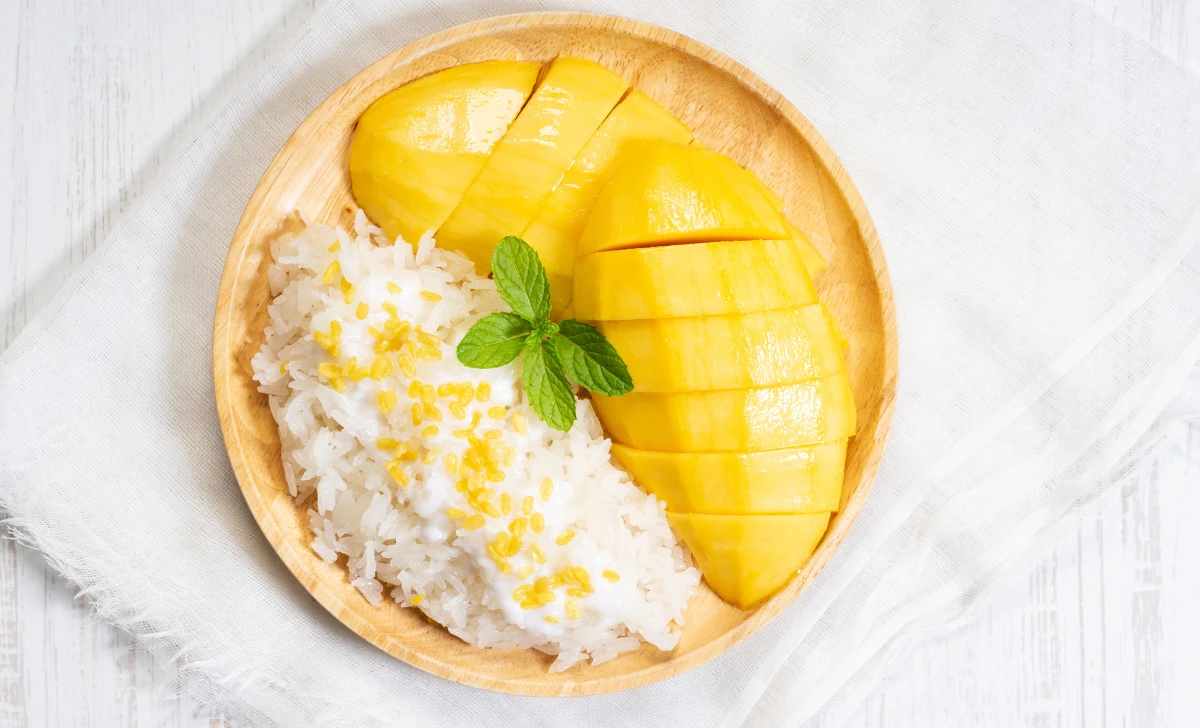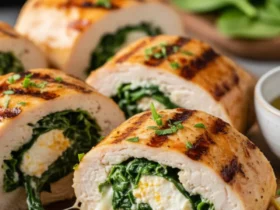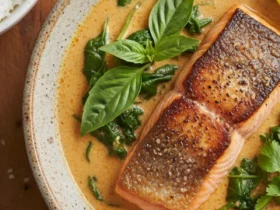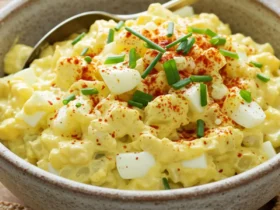Hey there, fellow food enthusiast! If you’re looking to tantalize your taste buds with a divine tropical dessert, you’ve stumbled upon the right recipe. Today, we’re diving into the delightful world of Coconut Sticky Rice with Mango. This mouthwatering Thai dessert is an exquisite blend of creamy coconut-infused sticky rice and the succulent goodness of ripe mangoes. Get ready to embark on a culinary journey that will leave you craving for more!
[ez-toc]
History
Hello there, curious culinary explorers! Today, we’re delving into the captivating history of a dessert that has delighted taste buds for generations – the Coconut Sticky Rice with Mango. This beloved Thai delicacy isn’t just a recipe; it’s a tale of cultural fusion, agricultural ingenuity, and a harmonious marriage of flavors. Join me as we embark on a journey through time to uncover the origins and evolution of this sweet masterpiece.
Origins in the Heart of Thailand
The roots of Coconut Sticky Rice with Mango can be traced back to the heart of Thailand, a country renowned for its vibrant cuisine and rich culinary traditions. While the exact origins are shrouded in the mists of time, it’s believed that this dessert has been savored for centuries, passed down through generations as a treasured family recipe.
A Marriage of Flavors
The genius of this dessert lies in its simplicity. The sweet, creamy goodness of coconut-infused sticky rice perfectly complements the succulent, tangy flavors of ripe mangoes. This exquisite pairing is a testament to the Thai people’s deep understanding of flavors and their artistry in creating dishes that engage every sense.
Cultural Significance
Coconut Sticky Rice with Mango isn’t just a treat for the palate; it holds cultural significance as well. In Thailand, mangoes are often referred to as the “king of fruits,” and this dessert is no less than royalty on a plate. It’s frequently enjoyed during special occasions, festivals, and celebrations, reflecting the Thai people’s joyous spirit and their penchant for culinary craftsmanship.
Influence of Agriculture
The availability of ingredients played a pivotal role in shaping this dessert’s history. Thailand’s fertile land and tropical climate made it conducive for cultivating rice and mangoes, the primary components of this dish. Sticky rice, a unique variety of rice, became the cornerstone of the recipe, contributing to the dessert’s distinct texture and consistency.
Evolution through Time
As time marched forward, so did the evolution of Coconut Sticky Rice with Mango. While the core elements remained consistent, creative variations emerged. Chefs and home cooks alike experimented with ingredients, adding twists such as pandan leaves for aroma, caramelized coconut toppings for extra flavor, and even exploring alternative fruit medleys.
From Local Delicacy to Global Sensation
The 20th century marked a turning point for this humble yet extraordinary dessert. As international travel increased and cultural exchange became more prevalent, the fame of Coconut Sticky Rice with Mango spread far beyond Thailand’s borders. It graced the menus of Thai restaurants around the world, capturing the hearts (and stomachs) of food enthusiasts everywhere.
Preserving Traditions in Modern Times
In today’s fast-paced world, where culinary trends come and go, Coconut Sticky Rice with Mango remains a timeless treasure. With the advent of the internet, the recipe has become more accessible than ever, allowing food lovers from all walks of life to recreate this Thai masterpiece in their own kitchens.
A Sweet Legacy Lives On
And so, dear readers, we conclude our journey through the historical tapestry of Coconut Sticky Rice with Mango. What began as a simple blend of ingredients has evolved into a dish that encapsulates centuries of tradition, culture, and culinary innovation. As you indulge in this dessert, remember that each bite carries with it a piece of Thailand’s past and an ode to the enduring legacy of a sweet delight that knows no bounds.
Time
| Step | Time |
|---|---|
| Rinse the Rice | 10 minutes |
| Soak the Rice | 30 minutes – 1 hour |
| Steam the Rice | 25-30 minutes |
| Prepare Coconut Sauce | 5 minutes |
| Infuse Rice with Coconut Sauce | 20-30 minutes |
| Peel and Slice Mangoes | 10 minutes |
| Arrange Sticky Rice on Plate | 5 minutes |
| Place Mango Slices | 3 minutes |
| Sprinkle Sesame Seeds | 1 minute |
| Garnish with Mint Leaves | 1 minute |
| Total Cooking and Preparation Time | Approximately 2 hours |
Please note that the total cooking and preparation time is an approximation and may vary based on individual cooking skills and kitchen equipment. Enjoy your delicious Coconut Sticky Rice with Mango!
Ingredients
| Ingredients | Quantity |
|---|---|
| Glutinous Rice | 1 cup |
| Coconut Milk | 1/2 can |
| White Sugar | 1/4 cup |
| Salt | 1/8 teaspoon |
| Ripe Mangoes | 1-2, depending on size |
| Sesame Seeds | For garnishing |
| Fresh Mint Leaves | For garnishing |
Please adjust the quantities based on your preferences and the size of the mangoes. Enjoy your delightful dessert for two!
Directions
Step 1: Rinse the Rice
Start by rinsing the glutinous rice under cold water until the water runs clear. This helps remove excess starch and ensures a perfect texture.
Step 2: Soak the Rice
Place the rinsed rice in a bowl and cover it with water. Allow it to soak for about 30 minutes to an hour. This soaking process ensures even cooking and optimal texture.
Step 3: Steam the Rice
Drain the soaked rice and transfer it to a steamer lined with cheesecloth. Steam the rice for approximately 25-30 minutes until it’s tender and fully cooked.
Step 4: Prepare the Coconut Sauce
In a saucepan, combine the coconut milk, white sugar, and salt. Allow the mixture to simmer over low heat, stirring occasionally, until the sugar completely dissolves.
Step 5: Infuse Rice with Coconut Sauce
Pour the luscious coconut sauce over the cooked sticky rice. Gently fold the rice to coat it evenly with the aromatic coconut goodness. Let the rice soak up the flavors for about 20-30 minutes.
Step 6: Peel and Slice Mangoes
Select ripe mangoes that yield slightly to gentle pressure when squeezed. Peel and slice the mangoes into thin, juicy pieces. Set them aside for the final assembly.
Step 7: Arrange Sticky Rice on Plate
Take a serving plate and arrange a portion of the coconut-infused sticky rice. Flatten it slightly to create a rice bed for your mango slices.
Step 8: Place Mango Slices
Artfully place the ripe mango slices on top of the rice bed. You can arrange them in a fan-like pattern for an elegant presentation.
Step 9: Sprinkle Sesame Seeds
Sprinkle sesame seeds over the mango slices. These tiny seeds not only add a pleasant crunch but also enhance the visual appeal of the dessert.
Step 10: Garnish with Mint Leaves
Finish off by scattering a few fresh mint leaves over the dessert. The mint’s aroma beautifully complements the coconut and mango flavors.
Enjoy Your Coconut Sticky Rice with Mango!
Your culinary masterpiece is now ready to be savored. Indulge in the creamy coconut rice, relish the sweetness of ripe mangoes, and experience the perfect balance of flavors in every bite. This delightful dessert is a true celebration of the tropical goodness that Coconut Sticky Rice with Mango brings to your palate.
Equipment Required
Nutrition Information
| Nutrition Facts | Per Serving |
|---|---|
| Serving Size | 1 serving (approx. 1 cup) |
| Calories | 300 |
| Total Fat | 6g |
| Saturated Fat | 5g |
| Cholesterol | 0mg |
| Sodium | 30mg |
| Total Carbohydrates | 60g |
| Dietary Fiber | 2g |
| Total Sugars | 30g |
| Protein | 3g |
| Vitamin D | 0mcg |
| Calcium | 20mg |
| Iron | 1.2mg |
| Potassium | 160mg |
Percent Daily Values are based on a 2,000 calorie diet. Your daily values may be higher or lower depending on your calorie needs.
Please note that the nutrition information provided is an estimate and may vary based on the specific ingredients used and portion sizes. Enjoy your Coconut Sticky Rice with Mango mindfully!
Tips
- Use Glutinous Rice: Stick to glutinous rice for that signature sticky texture. Regular rice won’t yield the same results.
- Perfect Steaming: Ensure the rice is fully cooked but not mushy after steaming. Each grain should maintain its structure.
- Soak Mindfully: Soak the rice for the recommended time. This step is crucial for even cooking and achieving the desired texture.
- Choose Ripe Mangoes: Opt for ripe mangoes with a gentle yield to pressure and a fragrant aroma at the stem end.
- Even Coconut Coating: When infusing the rice with the coconut sauce, gently fold to ensure every grain is coated evenly.
- Garnishing Finesse: Arrange the mango slices and garnishes thoughtfully for an appealing presentation.
- Sesame Seed Flair: Toast the sesame seeds lightly for enhanced flavor before sprinkling them over the dessert.
- Play with Texture: Experiment with the consistency of the coconut sauce to achieve your preferred level of creaminess.
Pros & Cons
| Pros | Cons |
|---|---|
| ✅ Delicious fusion of flavors | ❌ High in sugar and calories |
| ✅ Exotic and visually appealing | ❌ May not be suitable for coconut allergies |
| ✅ Reflects Thai culinary heritage | ❌ Sticky rice may be hard to find |
| ✅ Simple and elegant dessert | ❌ Requires soaking and steaming time |
| ✅ Versatile – variations to explore | ❌ Mango availability may be seasonal |
Conclusion
In the realm of culinary delights, few experiences can match the sheer joy of Coconut Sticky Rice with Mango. This recipe, a harmonious blend of creamy coconut-infused sticky rice and the succulent allure of ripe mangoes, is a sensory journey that captures the heart and palate alike.
With its roots deeply embedded in Thai culture, this dessert is more than just a dish – it’s a bridge to a world of flavors, traditions, and artistry. From the moment you take that first bite, you’ll be transported to a tropical paradise, where the sweetness of mangoes dances with the velvety coconut-infused rice in perfect harmony.
As you embark on this culinary adventure, don’t be afraid to infuse your creativity. Explore variations, personalize garnishes, and make it uniquely yours. Whether it’s a special occasion, a gathering with loved ones, or simply a moment of self-indulgence, Coconut Sticky Rice with Mango is the perfect companion.
So, fellow food enthusiast, take a leap into a world of exquisite flavors, where every spoonful is a celebration of the beauty of nature’s bounty. Channel your inner chef, follow these easy steps, and let your kitchen be the stage for a dessert that’s not just delectable but a tribute to the magic of food itself. It’s time to treat yourself to the tropical symphony that is Coconut Sticky Rice with Mango – an experience that’s sure to leave you craving more.
Facts
- Fact 1: A Mango Royalty 👑
- Did you know that in Thailand, mangoes are often referred to as the “king of fruits”? 🥭 The title fits perfectly as they reign over this dessert, adding a burst of sweet, tangy goodness to the Coconut Sticky Rice with Mango.
- Fact 2: Steeped in Tradition 🌾
- Sticky rice, the heart of this dessert, has been a staple in Thai cuisine for centuries. 🍚 It’s not just rice; it’s a symbol of cultural heritage, connecting generations through the art of preparing and sharing delightful dishes.
- Fact 3: The Aroma Alchemy 🌿
- Pandan leaves, often used to infuse fragrance into the coconut sauce, are known as the “vanilla of Southeast Asia.” 🌱 Their enchanting aroma transforms your dessert experience, making each bite a sensory adventure.
- Fact 4: Mango Mythology 🌞
- In many cultures, mangoes are associated with love and prosperity. 💖🌴 It’s said that sharing a mango with someone symbolizes friendship, making Coconut Sticky Rice with Mango not just a dessert but a sweet gesture of affection.
- Fact 5: A Tropical Symphony 🏝️
- Coconut Sticky Rice with Mango isn’t just a dish; it’s a symphony of textures and flavors that dance in perfect harmony. 🎶 The creamy rice, the succulent mangoes, and the aromatic coconut sauce create a melody that lingers on your taste buds.
FAQ’s
Can I use regular rice instead of glutinous rice?
While sticky rice is traditionally used for its unique texture, you can experiment with regular rice for a different outcome.
Is there a substitute for coconut milk for a lighter version?
Absolutely! You can use almond milk or coconut water for a lighter twist.
How do I know if the rice is steamed perfectly?
The rice should be tender, yet each grain should maintain its structure. It shouldn’t be mushy.
Can I prepare the coconut sauce in advance?
Of course! You can prepare the sauce ahead of time and reheat it gently before pouring it over the rice.
Is this dessert gluten-free?
Yes, it’s naturally gluten-free since it’s made from glutinous rice, which is gluten-free despite its name.
Can I use frozen mangoes for this recipe?
Fresh ripe mangoes are ideal, but you can use thawed frozen mangoes if fresh ones aren’t available. However, fresh mangoes offer the best flavor and texture.
Can I refrigerate leftovers and enjoy them later?
Absolutely! Store leftovers in an airtight container in the refrigerator. Reheat gently before serving.
How long can I store leftover Coconut Sticky Rice with Mango?
Leftovers can be stored for up to 2 days in the refrigerator. However, for the best taste and texture, enjoy it as fresh as possible.
Can I use other tropical fruits instead of mangoes?
Yes, you can get creative! Papaya, jackfruit, and lychee are great alternatives that complement the coconut rice beautifully.
Can I make the sticky rice in a rice cooker?
Absolutely! Follow your rice cooker’s instructions for sticky rice. Once cooked, proceed with the coconut sauce and mango assembly as described in the recipe.












Leave a Review